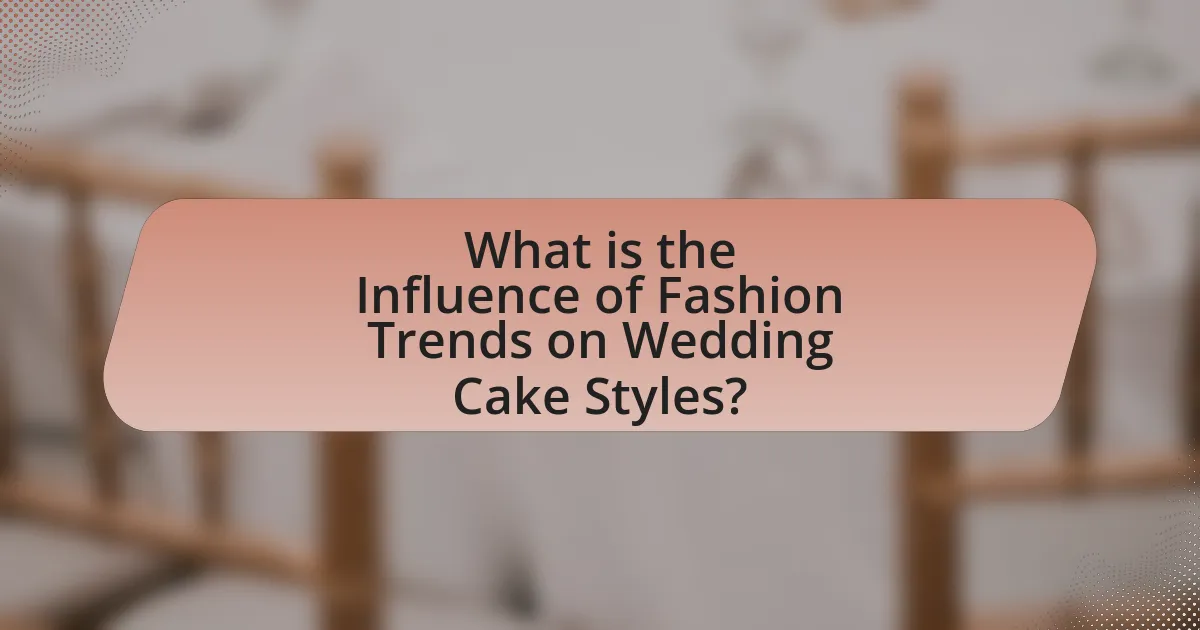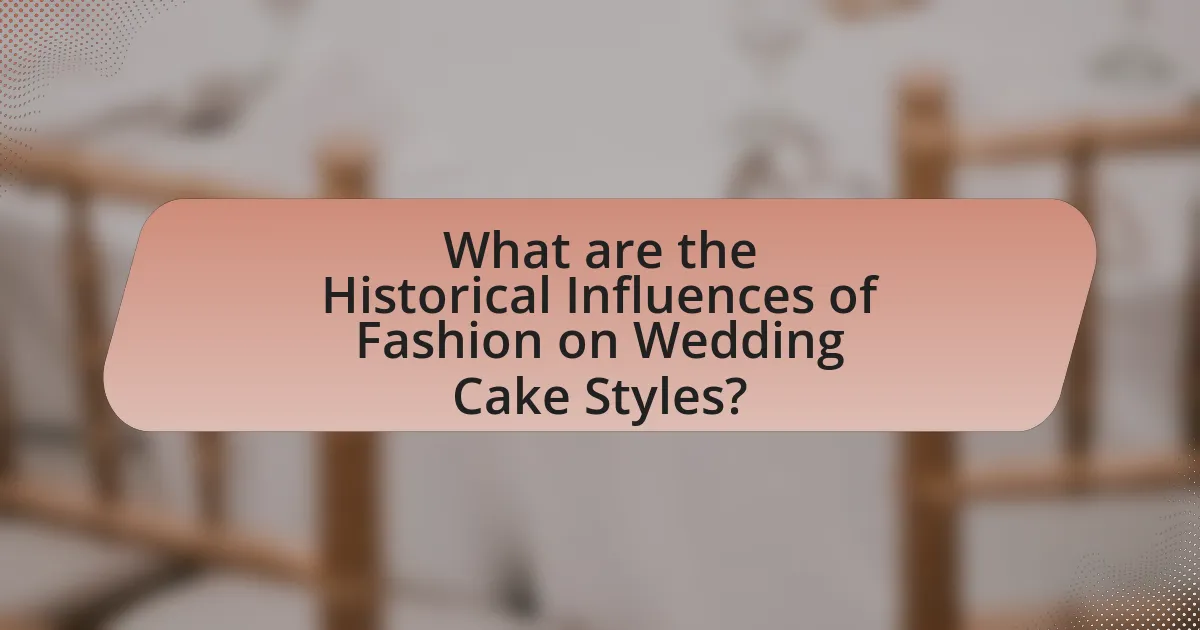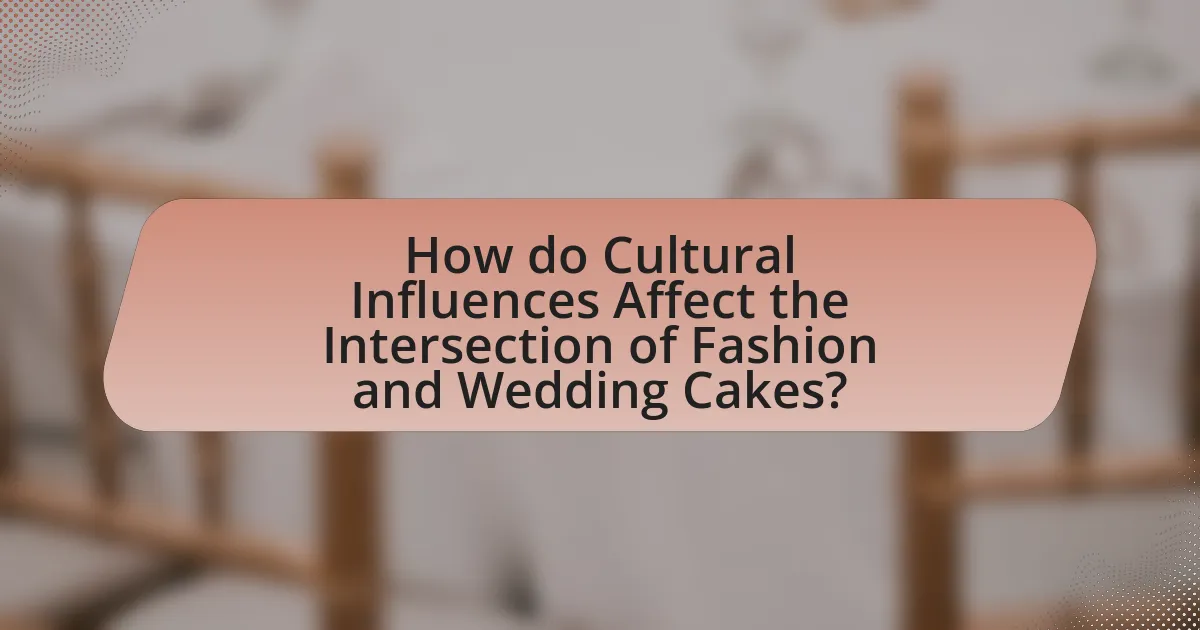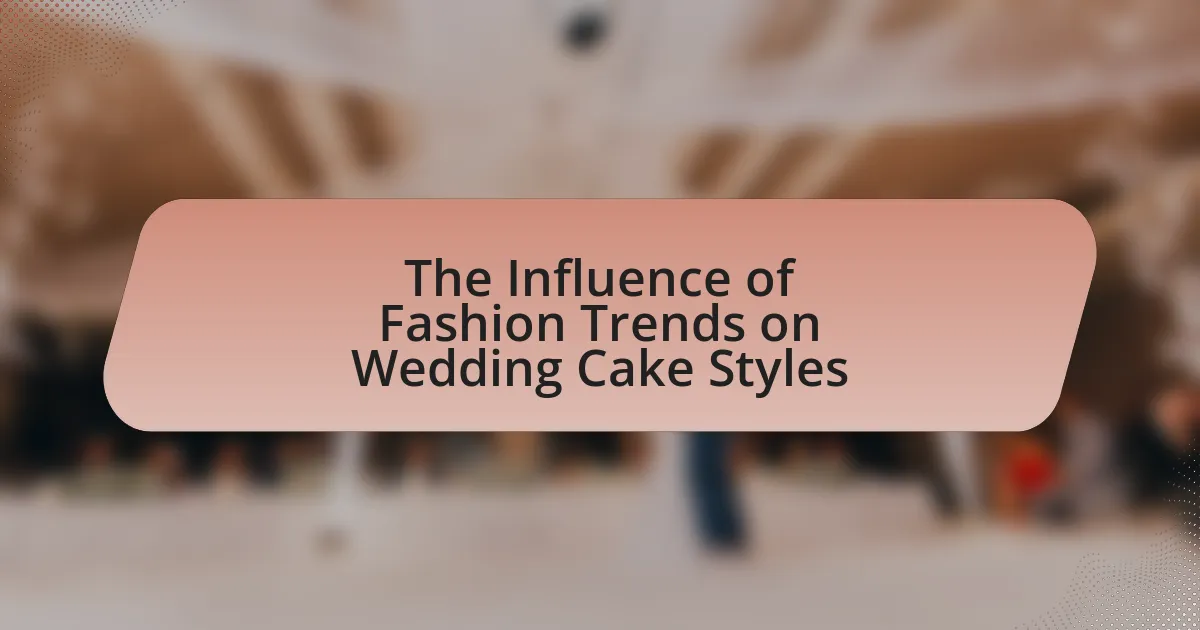The article examines the influence of fashion trends on wedding cake styles, highlighting how design elements, color palettes, and aesthetics are shaped by contemporary fashion. It discusses the correlation between minimalist fashion and the rise of simple, elegant cake designs, as well as the impact of popular colors and materials on cake decoration choices. The article also explores historical influences, cultural factors, and the role of social media in shaping cake trends, emphasizing the importance of aligning wedding cakes with current fashion to enhance their visual appeal and relevance. Additionally, it provides insights into how couples can incorporate these trends into their cake designs and offers best practices for cake designers to stay updated on evolving styles.

What is the Influence of Fashion Trends on Wedding Cake Styles?
Fashion trends significantly influence wedding cake styles by dictating design elements, color palettes, and overall aesthetics. For instance, the rise of minimalist fashion has led to an increase in simple, elegant cake designs featuring clean lines and subtle textures. Additionally, popular colors in fashion, such as pastels or bold jewel tones, often translate into cake decoration choices, aligning with the couple’s overall wedding theme. The incorporation of trendy materials, like metallics or natural elements, reflects current fashion preferences, showcasing how closely intertwined these two industries are. This relationship is evident in the way cake designers adapt to seasonal fashion trends, ensuring that wedding cakes remain contemporary and appealing to modern couples.
How do fashion trends shape the aesthetics of wedding cakes?
Fashion trends significantly shape the aesthetics of wedding cakes by influencing design elements such as color, texture, and decoration. For instance, the rise of minimalist fashion has led to an increase in simple, elegant cake designs featuring clean lines and muted color palettes. Additionally, trends like the use of metallics and bold colors in fashion have translated into wedding cakes adorned with gold leaf or vibrant hues, reflecting contemporary styles. According to a survey by The Knot, 30% of couples in 2022 opted for cakes that mirrored current fashion trends, showcasing the direct correlation between fashion and cake design.
What specific fashion elements are reflected in wedding cake designs?
Wedding cake designs reflect specific fashion elements such as color palettes, textures, and patterns. For instance, the use of trending colors like pastels or metallics in wedding cakes mirrors current fashion trends seen on runways. Textures such as ruffles, lace, or smooth finishes often emulate popular fabric styles, while patterns like floral or geometric designs are inspired by contemporary clothing motifs. These elements demonstrate a direct correlation between fashion and cake design, as both industries frequently draw inspiration from each other to create visually appealing aesthetics.
How do color palettes in fashion influence cake decoration choices?
Color palettes in fashion significantly influence cake decoration choices by dictating the colors and themes that are popular at any given time. For instance, when pastel colors dominate fashion trends, cake decorators often incorporate similar soft hues into their designs to align with current aesthetic preferences. This alignment is evident in wedding cakes, where couples frequently choose cake colors that match their wedding attire, reflecting the latest fashion trends. Research indicates that color psychology plays a role in consumer choices, with certain colors evoking specific emotions and associations, further reinforcing the connection between fashion palettes and cake decoration.
Why is it important to consider fashion trends when designing wedding cakes?
Considering fashion trends when designing wedding cakes is crucial because it ensures that the cake aligns with contemporary aesthetics and preferences. Wedding cakes serve as a focal point in wedding celebrations, and incorporating current trends can enhance their visual appeal and relevance. For instance, the rise of minimalist designs and natural elements in fashion has influenced cake styles, leading to the popularity of simple, elegant cakes adorned with fresh flowers and greenery. This alignment with fashion trends not only satisfies the couple’s desire for a modern celebration but also reflects broader cultural movements, making the cake a more integral part of the overall wedding theme.
How do current fashion trends impact couples’ cake selections?
Current fashion trends significantly influence couples’ cake selections by dictating design aesthetics, color palettes, and flavor profiles. For instance, the rise of minimalist and modern wedding styles has led couples to favor simple, elegant cakes with clean lines and fewer tiers, reflecting the overall trend towards understated sophistication. Additionally, popular colors in fashion, such as pastels or bold jewel tones, often translate into cake designs, with couples opting for cakes that complement their wedding color schemes. According to a survey by The Knot, 30% of couples reported choosing cake designs that align with current trends, showcasing the direct correlation between fashion and cake selection.
What role does social media play in the intersection of fashion and wedding cakes?
Social media significantly influences the intersection of fashion and wedding cakes by serving as a platform for trend dissemination and visual inspiration. Platforms like Instagram and Pinterest allow users to share and discover wedding cake designs that reflect current fashion trends, such as color palettes, textures, and styles. For instance, a study by the Wedding Report found that 75% of couples use social media to gather ideas for their wedding, highlighting its role in shaping preferences. This visual sharing fosters a culture where wedding cakes are not only culinary creations but also fashion statements, aligning with bridal gown trends and overall wedding aesthetics.

What are the Historical Influences of Fashion on Wedding Cake Styles?
Historical influences of fashion on wedding cake styles include the evolution of design elements such as color, texture, and ornamentation, which reflect prevailing trends in clothing and accessories. For instance, during the Victorian era, intricate lace patterns and floral motifs became popular in both fashion and cake design, leading to the use of fondant and royal icing to replicate these details on wedding cakes. Additionally, the Art Deco movement in the 1920s introduced geometric shapes and bold colors, which influenced cake designs to adopt streamlined forms and metallic finishes. The rise of celebrity weddings in the late 20th century further impacted cake styles, as couples sought to emulate the lavish designs seen in high-profile events, resulting in multi-tiered cakes adorned with elaborate decorations. These historical fashion trends have consistently shaped the aesthetic choices in wedding cake design, demonstrating a clear connection between the two realms.
How have wedding cake styles evolved alongside fashion trends over the decades?
Wedding cake styles have evolved significantly alongside fashion trends over the decades, reflecting changes in aesthetics, materials, and cultural influences. In the early 20th century, wedding cakes were often simple and modest, mirroring the conservative fashion of the time, with minimal decoration and a focus on traditional flavors. As the 1920s brought about the flapper style, wedding cakes became more elaborate, featuring intricate designs and layers, paralleling the bold and extravagant fashion choices of the era.
The post-World War II period saw a shift towards more whimsical and colorful cakes, influenced by the vibrant fashion of the 1950s, which embraced pastel colors and playful designs. The 1970s introduced a more natural and rustic aesthetic, with cakes adorned with fresh flowers and earthy tones, reflecting the bohemian fashion trends of the time.
In the 1980s and 1990s, wedding cakes became increasingly extravagant, often featuring multiple tiers and elaborate fondant designs, mirroring the opulent fashion trends characterized by bold patterns and dramatic silhouettes. The turn of the 21st century saw a return to simplicity and minimalism, influenced by contemporary fashion that favored clean lines and understated elegance, leading to the popularity of naked cakes and minimalist designs.
Overall, the evolution of wedding cake styles has closely mirrored the changing landscape of fashion, with each decade’s trends influencing the aesthetics and presentation of these iconic desserts.
What were the key fashion movements that influenced wedding cake designs in the past?
Key fashion movements that influenced wedding cake designs in the past include the Victorian era’s emphasis on opulence, Art Deco’s geometric elegance, and the minimalist trends of the late 20th century. The Victorian era, characterized by intricate lace and floral patterns, led to elaborate cake designs adorned with sugar flowers and detailed piping. Art Deco, emerging in the 1920s, introduced sleek lines and bold colors, inspiring cakes with geometric shapes and metallic accents. In contrast, the minimalist trends of the late 20th century favored simple, clean designs, often featuring single-tier cakes with understated decorations, reflecting a shift towards modern aesthetics. These movements collectively shaped the evolution of wedding cake styles, aligning them with contemporary fashion sensibilities.
How did historical events shape the relationship between fashion and wedding cakes?
Historical events significantly influenced the relationship between fashion and wedding cakes by dictating societal norms and aesthetics. For instance, during the Victorian era, the introduction of white wedding dresses symbolized purity and led to the creation of white icing on wedding cakes, reflecting the bride’s attire. Additionally, the industrial revolution allowed for mass production of sugar and cake ingredients, making elaborate cakes more accessible and fashionable for weddings. The rise of celebrity weddings in the 20th century further shaped cake designs, as couples sought to emulate the extravagant styles seen in media, leading to trends like multi-tiered cakes adorned with intricate decorations. These historical shifts illustrate how changes in fashion directly impacted the design and presentation of wedding cakes over time.
What are the current fashion trends impacting wedding cake styles?
Current fashion trends impacting wedding cake styles include minimalism, bold colors, and the use of natural elements. Minimalist designs focus on clean lines and simple aesthetics, reflecting a broader trend in wedding decor that favors understated elegance. Bold colors, such as deep greens and rich jewel tones, are gaining popularity, moving away from traditional pastels to create striking visual statements. Additionally, the incorporation of natural elements like fresh flowers, fruits, and organic textures aligns with the growing trend of sustainability in weddings, emphasizing a connection to nature. These trends are supported by industry reports indicating a shift towards personalized and unique cake designs that reflect individual couple’s styles and preferences.
Which contemporary fashion designers are influencing wedding cake aesthetics?
Contemporary fashion designers influencing wedding cake aesthetics include Vera Wang, Christian Siriano, and Monique Lhuillier. Vera Wang’s bridal collections often feature intricate lace and floral designs, which have inspired cake decorators to incorporate similar elements into their creations. Christian Siriano is known for his bold colors and dramatic silhouettes, prompting cake designers to experiment with vibrant hues and unique shapes. Monique Lhuillier’s romantic and whimsical style has led to the popularity of soft pastels and delicate details in wedding cakes. These designers have significantly shaped current trends in wedding cake aesthetics, reflecting their signature styles in edible art.
How do seasonal fashion trends affect wedding cake themes?
Seasonal fashion trends significantly influence wedding cake themes by dictating color palettes, design elements, and overall aesthetics. For instance, spring trends often feature pastel colors and floral designs, reflecting the season’s natural beauty, while autumn trends may incorporate rich, warm hues and rustic elements, aligning with the seasonal harvest. This correlation is evident in the increasing popularity of cakes adorned with seasonal motifs, such as leaves in fall or blossoms in spring, which mirrors the fashion industry’s seasonal shifts. Additionally, designers often draw inspiration from runway styles, leading to cakes that echo the latest fabric patterns and textures, thereby creating a cohesive visual experience for weddings.

How do Cultural Influences Affect the Intersection of Fashion and Wedding Cakes?
Cultural influences significantly shape the intersection of fashion and wedding cakes by dictating design aesthetics, color palettes, and flavor profiles. For instance, in Western cultures, traditional white wedding cakes symbolize purity and are often adorned with intricate lace designs, reflecting contemporary bridal fashion trends. Conversely, in cultures such as Indian or Chinese, wedding cakes may incorporate vibrant colors and unique flavors like saffron or red bean, aligning with traditional attire and celebratory customs. This interplay is evident in the rise of fusion cakes, which blend elements from different cultures, showcasing how global fashion trends impact local cake designs.
What cultural factors contribute to the design of wedding cakes influenced by fashion?
Cultural factors such as regional traditions, historical significance, and contemporary aesthetics significantly influence the design of wedding cakes in relation to fashion. For instance, in Western cultures, the white wedding cake symbolizes purity and is often adorned with intricate designs that reflect current fashion trends, such as lace patterns or floral motifs. Additionally, cultural events like royal weddings can set trends that impact wedding cake designs, as seen with the popularity of fruitcake after the royal wedding of Prince William and Kate Middleton in 2011. Furthermore, the rise of social media has led to a fusion of global styles, allowing for diverse influences in cake design, such as incorporating elements from Asian, African, or Latin American traditions. This blending of cultural elements showcases how fashion trends and cultural heritage shape the aesthetics of wedding cakes.
How do regional fashion trends shape local wedding cake styles?
Regional fashion trends significantly influence local wedding cake styles by dictating color palettes, design elements, and flavor preferences. For instance, in regions where minimalist fashion is prevalent, wedding cakes often reflect this simplicity through clean lines and understated decorations. Conversely, areas with vibrant fashion trends may see wedding cakes adorned with bold colors and intricate designs. A study by the American Institute of Baking highlights that regional preferences in flavors, such as citrus in coastal areas or rich chocolate in colder climates, also align with local culinary trends, further shaping wedding cake styles. This interplay between fashion and culinary arts illustrates how cultural aesthetics manifest in wedding celebrations.
What are some examples of cultural fashion trends reflected in wedding cakes?
Cultural fashion trends reflected in wedding cakes include the use of specific colors, designs, and themes that resonate with cultural heritage. For instance, in Indian weddings, wedding cakes often feature vibrant colors and intricate designs inspired by traditional textiles and henna patterns, showcasing a blend of modern and traditional aesthetics. In contrast, Western weddings may emphasize minimalist designs with neutral color palettes, reflecting contemporary fashion trends that prioritize simplicity and elegance. Additionally, the incorporation of cultural symbols, such as Celtic knots in Irish weddings or floral motifs in Japanese ceremonies, further illustrates how cultural fashion influences cake design. These trends are validated by the increasing popularity of themed weddings, where couples choose cake designs that align with their cultural backgrounds and personal styles.
How can couples incorporate fashion trends into their wedding cake designs?
Couples can incorporate fashion trends into their wedding cake designs by selecting colors, textures, and patterns that reflect current styles in the fashion industry. For instance, the use of popular color palettes, such as pastels or bold jewel tones, can enhance the visual appeal of the cake. Additionally, incorporating textures like ruffles, metallic finishes, or geometric shapes can mirror trends seen on runways. According to a report by The Knot, 2022 wedding trends highlighted the popularity of minimalist designs and natural elements, which couples can integrate into their cake aesthetics. By aligning their cake design with these fashion trends, couples can create a cohesive and stylish wedding theme.
What tips can couples follow to align their wedding cake with current fashion trends?
Couples can align their wedding cake with current fashion trends by selecting designs that reflect contemporary aesthetics, such as minimalism, bold colors, or unique textures. For instance, the trend of incorporating natural elements, like fresh flowers or greenery, can enhance the cake’s visual appeal while staying in line with current wedding themes. Additionally, couples should consider popular flavors and fillings that resonate with modern tastes, such as unique combinations or locally sourced ingredients. Research indicates that cakes featuring geometric patterns and metallic accents are increasingly favored, reflecting broader design trends in weddings. By staying informed about these styles through wedding magazines and social media platforms, couples can ensure their cake is both fashionable and memorable.
How can wedding cake designers stay updated on fashion trends?
Wedding cake designers can stay updated on fashion trends by actively following industry publications, attending bridal shows, and engaging with social media platforms. Industry publications such as “Brides” and “The Knot” regularly feature the latest trends in wedding aesthetics, including cake designs. Bridal shows provide firsthand exposure to emerging styles and allow designers to network with other professionals. Additionally, platforms like Instagram and Pinterest showcase real-time trends, enabling designers to observe popular themes and color palettes in wedding cakes. This multi-faceted approach ensures that wedding cake designers remain informed and can adapt their creations to align with current fashion trends.
What are the best practices for blending fashion trends with wedding cake styles?
The best practices for blending fashion trends with wedding cake styles include incorporating current color palettes, utilizing popular textures, and reflecting trending design elements. For instance, if pastel colors are in vogue for bridal wear, a wedding cake can feature similar hues in its frosting or decorations. Additionally, if lace or floral patterns are trending in fashion, these can be mirrored in the cake’s design through intricate piping or edible lace. Research indicates that aligning cake aesthetics with contemporary fashion not only enhances visual appeal but also creates a cohesive theme for the wedding, as evidenced by the growing popularity of styled shoots that showcase this integration.
